Using Binoculars for Astronomy
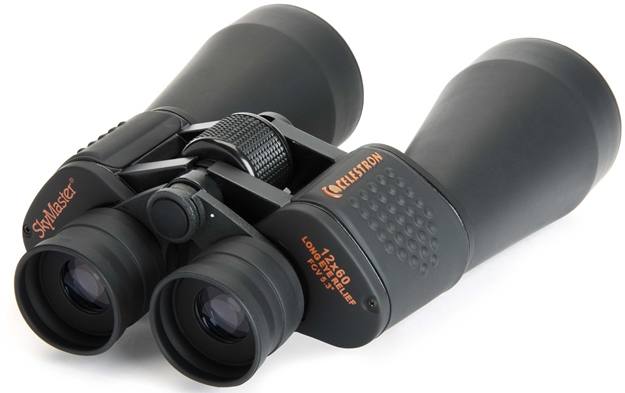
Most people associate telescopes and night-time with astronomy. On the other hand, binoculars are the instrument of choice for many astronomers, especially as a “grab and go” instrument or for viewing large objects.
You can start off using binoculars that you have bought for other purposes, then consider a pair specifically for astronomy later.
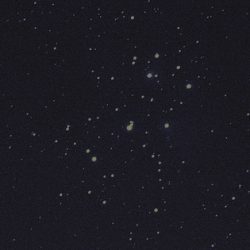 The key quality of binoculars is that they gather more light than your eyes alone. Larger binoculars have larger main (objective) lenses and gather more light than smaller ones. They make faint objects brighter and make some faint objects visible.
The key quality of binoculars is that they gather more light than your eyes alone. Larger binoculars have larger main (objective) lenses and gather more light than smaller ones. They make faint objects brighter and make some faint objects visible.
For example, if you look at the well-known star cluster the Seven Sisters (image right), you will see between six and 19 stars, depending on the clarity of the sky, light pollution and your eyesight. Using binoculars of about 50mm aperture, the number rises to around 30 to 50.
The distance between the stars is larger using binoculars for astronomy, thus making the view very pleasing. The photograph on the right shows how you can expect the Seven Sisters to appear in medium-sized/power binoculars.
Key Binocular Statistics for Astronomy
Binoculars are usually labelled with their magnification and aperture in millimeters(mm). For example, a pair of binoculars described as 12x50 has a magnification of 12 times and an aperture of 50mm.
The square of the aperture is related to the amount of light gathered. The exit pupil is the width of the beam of light leaving the binoculars at the eyepiece end and is the aperture divided by the magnification. 12x50 binoculars have an exit pupil of about 4.3mm.
The exit pupil should match the pupil width of the observer as closely as possible. For example, at a suburban place at night an adult has a pupil width of between 4 and 5mm, although this varies between people.
If the exit pupil is too wide, then some of the light hits the iris (of the eye) and not the pupil (however it does make it easier to line up your eyes with the shafts of light). If the exit pupil is too narrow, not all of the pupil is being used. In both cases, any shown objects appear fainter.
For terrestrial observation, the field of view is most commonly expressed as the width of the image you see at a certain distance (usually at 1000m or 1000 yards), but can also be measured in degrees (which is more commonly used in astronomy). Binoculars of the same magnification have varying fields of view, but is often approximately 50 divided by the magnification, regardless of the aperture.
As a comparison, the Moon is ½ degree wide. If the magnification is too large, objects can appear fainter, due to the narrow exit pupil and large objects cannot be seen in their entirety.
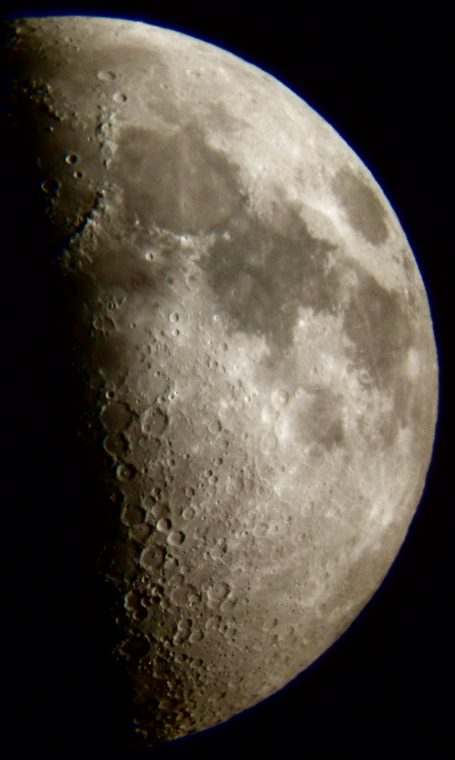
The Moon through Binoculars
The Moon is an ideal object to start with. It is bright and easy to find. You will learn a lot of observing skills that you can apply to other objects.
First Quarter
The photograph on the right shows the first quarter moon. The stand-out features are the seas (now known to be lava-filled plains) and the craters.
You can see these, even in small, otherwise inadequate ones. I have seen craters in 8x25 binoculars bought for £3.99 in a petrol station!
I prefer to use my 15x70 binoculars, as they show more detail. Not only does the additional magnification help but so does the larger aperture.
Many people find that larger binoculars need a tripod. I have quite steady hands, so I would suggest that 12x60 binoculars are more suitable for beginners for lunar viewing.
The Full Moon
Many experienced astronomers do not like the full moon, but I find it has a charm of its own.
Although the craters are not as prominent as at first quarter, you can see all the seas. Most craters are difficult to see, as the Sun is shining directly at them. Younger craters, such as Tycho (to the bottom and just to the left of centre) have ray systems that cover a large area of the lunar surface. They are caused by material ejected from the impact that caused the crater. For older craters, this material has been eroded by the solar wind.
You can also see the Moon around the time of last quarter, but it is more of an early morning object. You can also view the Moon during daylight, especially with large binoculars. A suitable telescope can show more detail than binoculars but requires more time to set up and is far less portable.
For more, take a look at the more in-depth guide to Viewing the Moon with Binoculars by Philip Pugh.
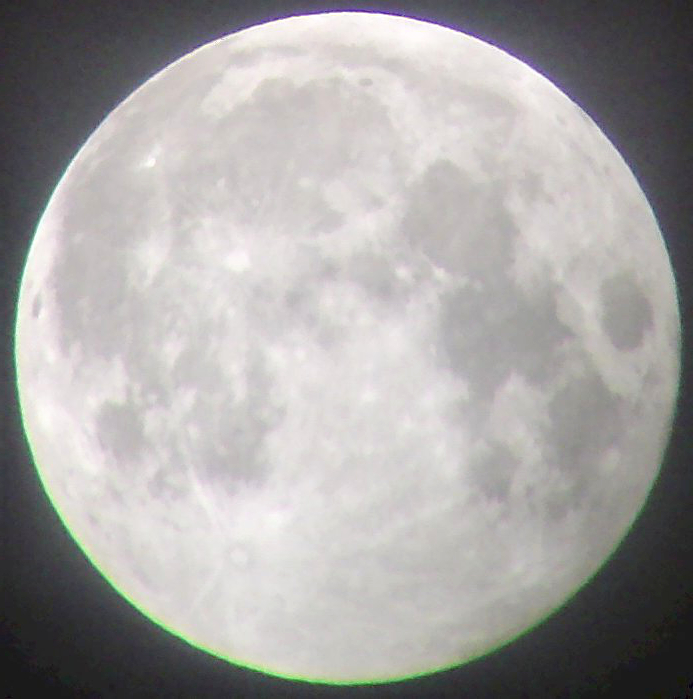
Viewing Planets with Binoculars
Planetary viewing is often better suited to telescopes, with their higher magnification and, generally, wider aperture. However, binoculars should not be discounted altogether as large, high power binoculars can show you some pretty cool stuff. For example:
- The phases of Venus
- Jupiter’s Galilean Moons
- Titan, Saturn’s largest moon
Venus
 Most of the time, Venus is a long way from us and only appears as a bright blob. When it comes within about 50 million miles of us, you can see the phases through binoculars, rather like the Moon but with no surface detail.
Most of the time, Venus is a long way from us and only appears as a bright blob. When it comes within about 50 million miles of us, you can see the phases through binoculars, rather like the Moon but with no surface detail.
The photograph on the right shows Venus when it was within 30 million miles and a very thin crescent. This occurs about once every two years.

Jupiter and its Moons
The diagram above shows Jupiter, its moons and some background stars. Only the brightest four are visible to binoculars when they are not behind, in front of or in the shadow of the planet. Large binoculars with high magnification give you the best chance of seeing moons that are close to the planet.
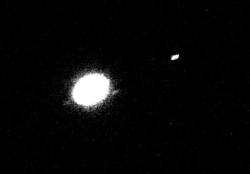
Saturn with Titan
Saturn appears as an oval shape in binoculars or it appears as a planet with handles because of the rings. Titan is quite faint and the only moon visible in large binoculars.
Deep Sky Binocular Astronomy
Many objects beyond our solar system, known collectively as “deep sky” are faint and large and ideal targets for binoculars. Examples are:
- The Seven Sisters
- The Hyades
- The Beehive
- M35
- Melotte 20
- Melotte 111
- The Wild Duck Cluster
- Perseus Double Cluster
Other objects within the range of small binoculars are:
- The Orion Great Nebula
- The Andromeda Galaxy
Large binoculars can show a lot more objects and reveal more detail in the brighter ones.
The only challenge for raw beginners is to learn how to find these objects and when they are visible.
Further Reading
If you would like some more information on using binoculars for astronomy, be sure to check out these guides:
Moon Binoculars
Second Astronomy guide by Philip Pugh. Here he explains the ideal binoculars for moon watching and what you can see in the different lunar phases.
Viewing Planets Through Binoculars by Philip Pugh
Guide to Choosing the Best Binoculars for Astronomy
Best 10x50 Binoculars for Astronomy
About Philip Pugh:
Philip is an uninteresting person who does interesting things. He had his first magazine article published in 1980 and has published four books in Patrick Moore’s “Practical Astronomy” series including those shown below.
Like nearly all writers, he has a “day job” and has spent most of his working life as a trainer or technical author. These days, astronomy is his only active interest outside work and family. He is best known for his interest in the Sun and one of his many activities is to monitor activity using binoculars (with suitable filters). He is also a keen photographer and takes quality photographs using budget equipment.

 Article | Posted by Philip Pugh
Article | Posted by Philip Pugh 



 Categories:
Categories:  Tags:
Tags: 

